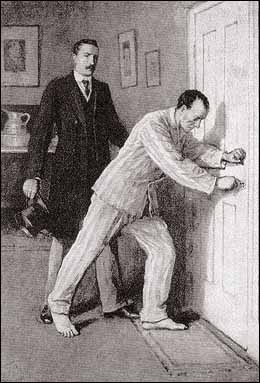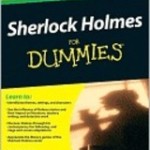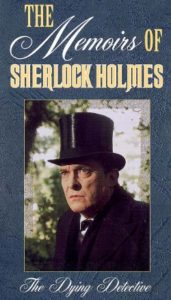A Scion Society of The Baker Street Irregulars

Data! Data! Data! – The Dying Detective
“‘Data! Data! Data!‘ he cried impatiently. ‘I can’t make bricks without clay.’”
– The Adventures of The Copper Beeches (COPP)

This column is composed of material (Data!) developed for a short course called Appreciating Sherlock Holmes that I teach twice a year in the Community Education Life Enrichment Program for a local community college. It is composed of “points of information” that are common to many / most / all of the 60 Canonical stories.
The information here has been researched by me or borrowed / stolen from many efforts of other Sherlockians.
HERE GOES This month’s story The Adventure of the Dying Detective
 CHRISTOPHER MORLEY SAID . . .
CHRISTOPHER MORLEY SAID . . .
Holmes pretense that he was dying of a fatal and rare disease, the “black Formosa corruption,” was a notable piece of acting and make lifelike (or deathlike) with theatrical effects. It deceived both Mrs. Hudson and the anxious Watson; why the performance was necessary is for the reader to learn. After three days of fasting Holmes was eager for a liberal meal at Simpson’s famous chophouse.
 DUMMIES SHORT SUMMARY (From Sherlock Holmes for Dummies by Steven Doyle & David Crowder)
DUMMIES SHORT SUMMARY (From Sherlock Holmes for Dummies by Steven Doyle & David Crowder)
“Sherlock Holmes is dying! Having contracted a deadly infectious disease while working on a case, the Great Detective is feverish and delirious. He sends Watson to summon the only man in London who can cure him. But will be come?”
PUBLISHING HISTORY
- This is the 46th of the 60 tales published
- It was first published in The Strand Magazine, December, 1913 and Collier’s Weekly, November 22, 1913
- It is part of His Last Bow collection by John Murray, London, 1917 and George H. Doran, New York, 1927
- The British illustrator was Walter Paget and the U.S. illustrator was Frederic Dorr Steele
HOW MANY WORDS?
According to C. E. Lauderback, 1960 – – found on SHERLOCKIAN.NET website of Chris Redmond
At 5,823 words DYIN has the 4th most words (#1 is VEIL – 4,499, #56 if NAVL – 12,701)
THE BEST OF SHERLOCK HOLMES (How do Sherlockians rate this story?)
- 1927 – Arthur Conan Doyle did not have it on his list of 12 favorites
- 1999 – Baker Street Irregulars voted it #27 of the 56 short stories
- 1999 – Sherlock Holmes Society of London voted it #26 of the 56 short stories
CLASSIFYING THE CASE (From the Wandering Gipsies of Grimpen Mire of Decatur, Alabama)
This case is one of 23 classified as a MURDER and one of 14 where the perpetrator was either killed, arrested, or otherwise satisfactorily handled.
CHRONOLOGICALLY SPEAKING
Doyle was often very vague about stating WHEN the tale took place and included few contemporary references to help. Whether this was done intentionally or unthinkingly, the dating of events in the Canon is a very popular pastime pursued by several of our “scholars” researching and justifying their results to no end. We will again default to William Baring-Gould’s dating of Saturday, November 19, 1887 making it 14th of the 60 stories in time. This means that Holmes is 33 and Watson 35.
WHAT ELSE HAPPENED IN YEAR – – – 1887?
It is always interesting to see what else in happening at the same time as the stories.
- British East Africa Company charter awarded.
- Victoria’s Golden Jubilee, end of Windsor Retirement.
- “People’s Palace” first stage, the Queen’s Hall, opens in East End.
- Irish Coercion Act; Irish Land Act.
- Charing Cross Road opens.
- Coal Mines Regulation Act, boys under 13 not to work underground, and under 12 at the surface.
- Ravenscourt Park, Hammersmith, opens after being bought by Metropolitan Board of Works.
- United States begins free mail delivery to homes of any community with a population of 10,000 or more.
- China recognizes Portugal right to the island of Macao.
- German Reichstag dissolved; alliance of Imperialists, Conservatives, some National Liberals–the Kartel–gave Bismarck majority in the new Reichstag; military grants renewed.
- Renewal of Russo-German ‘Reinsurance’ Treaty; and Triple Alliance.
- Italian force annihilated by Ethiopians at Dogali; designs on Tripoli conditionally supported by Britain and Germany.
- Union of Indo-China formed by France.
- Macao recognized as Portuguese by China.
- Yellow River floods in China, killing nearly a million people.
- S. Interstate Commerce Act, federal control of interstate railways.
- Work begins on Kiel Canal.
- Conan Doyle’s A Study in Scarlet, first Sherlock Holmes story, published.
- Rider Haggard publishes She and Allan Quatermain.
- Thomas Hardy publishes The Woodlanders, a novel.
- Cazanne paints The Blue Vase.
- Claude A. Debussy debuts Le Printemps.
- Monet paints Fields in Spring.
- Van Gogh paints Le Moulin de la Gallette and Boulevard de Clichy.
- Verdi debuts Othello.
- Radio waves discovered by Hertz.
- Bauxite, source of aluminum, is discovered in Georgia.
- Edison and Swan combine to produce ‘Ediswan’ electric lamps for domestic use
- Mach defines the Mach Number, now used in supersonic flight.
- Michelson and Morley experiment on the relative velocity of light in perpendicular directions; no speed difference found, results later lead to Einstein’s Theory of Relativity.
- Daimler four-wheeled motor car produced.
- Goodwin invents celluloid film.
- Construction of first British torpedo cruiser.
HOLMES AND WATSON – PERSONAL INFO
Holmes is residing at 221B as usual. Watson was living elsewhere in the second year of his married life.
DRAMATIS PERSONAE
We have a very small cast with many not even appearing.
- CULVERTON SMITH, a planter from Sumatra
- VICTOR SAVAGE, nephew of Culverton Smith
- STAPLES, Culverton Smith’s butler
- INSPECTOR MORTON
- SIR JASPER MEEKS
- PENROSE FISHER
- AINSTREE
“QUOTABLE SHERLOCK”
- Watson says “Mrs. Hudson, the landlady of Sherlock Holmes, was a longsuffering woman.”
- Hudson – – “He’s dying, Dr. Watson,” said she. “For three days he has been sinking, and I doubt if he will last the day. He would not let me get a doctor.
- “Well, Watson, we seem to have fallen upon evil days.”
- “If you approach me, Watson, I shall order you out of the house.”
- Watson – – “Holmes, you are not yourself. A sick man is but a child, and so I will treat you.”
- “I am somewhat exhausted: I wonder how a battery feels when it pours electricity into a non-conductor.”
- “You fidget me beyond endurance. You, a doctor – you are enough to drive a patient into an asylum.”
- “Indeed, I can not think why the whole bed of the ocean is not one solid mass of oysters, so prolific the creatures seem.”
- “You and I, Watson, we have done our part. Shall the world, then, be overrun by oysters? No, no; horrible!”
- “But I have reasons to suppose that this opinion would be very much more frank and valuable if he imagines that we are alone.”
- “The best way of successfully acting a part is to be it,” said Holmes.”
- “I give you my word that for three days I have tasted neither food nor drink until you were good enough to pour me out that glass of water. But it is the tobacco which I find most irksome.”
- “Among your many talents dissimulation finds no place.”
- “Three days of absolute fast doe not improve one’s beauty, Watson.”
- “Malingering is a subject upon which I have sometimes thought of writing a monograph.”
- “When we have finished at the police-station I think that something at Simpson’s would not be out of place.”
HOLMES’ FEE
There is no fee. (Of the fully recorded cases there are at least nine, REIG, BLAC, SIXN, GOLD, ABBE, CARD, DYIN, STUD, VALL, in which Holmes participated solely in order to assist the police.
SHERLOCK ON THE BIG SCREEN & THE LITTLE SCREEN
Down the list of screen performances, DYIN wasn’t good for cameras.
- 1921 – The Dying Detective with Eille Norwood
- 1994 – The Dying Detective with Jeremy Brett at Holmes
- 1999 – The Adventure of the Deranged Detective as an episode of Sherlock Holmes in the 22nd Century (Animated TV series)
SHERLOCK HOLMES IN DISGUISE
The Master of disguise used the deception of being disguised 14 times in 11 of the 60 stories, but he didn’t use any here.
UNRECORDED CASES (That involved Holmes)
Watson would tease / torture his readers with “I know something you don’t.” Oh my, how Sherlockians love this category. I have in excess of over 150 examples in my collection. Neither Watson no Holmes discussed any unrecorded cases in this tale.
IS THERE A DOCTOR IN THE HOUSE?
Victorian London, in the Holmes’ time, had approximately 1 doctor for every 100 people. 31 of the 60 tales have a doctor in them. This, of course, does not count Holmes’ Boswell. This listing is by Leslie Klinger in the Winter, 2015 edition of The Baker Street Journal. Whether it was Doyle or Watson, a doctor wrote the story.
In this story we have several doctors mentioned as possibly to treat Holmes.
- Sir Jasper Meek
- Penrose Fisher
- Ainstree
FAINTING IN THE CANON (courtesy of Sherlockian Karen Murdock)
Fainting is extremely common in the Canon, appearing, in some form, in 37 of the 60 tales. In 21 cases, someone actually faints. In 22 cases someone almost faints. And in 5 cases someone pretends to faint. In this month’s story, it is Holmes and he pretends to faint.
HOLMES’S PUBLISHED & PROJECTED WORKS
Sherlockians love this topic and are regularly searching for these items. Holmes mentions published or projected works in 11 of the stories. This adventure gets Holmes to declare that he should write a monograph on malingering.
NEWSPAPERS (Real and Fictional)
Though included in only 20 tales some of our more obsessed Sherlockians love this one. No mention of the press by name in this tale.
ANNOTATED SHERLOCK
The 60 Sherlock Holmes stories used English as spoken in England from the 1880’s until the 1910’s. Some words are foreign to us today and need a “contemporary translation.” This month’ story only give us a single term needing explanation.
- . . . “a hectic fever” in one that is fluctuating but persistently recurrent.
WEAPONS (from A Compendium of Canonical Weaponry by Dettman and Bedford)
A means by which one contends against another” … utilized in 57 of the 60 tales (all but CREE, 3STU, & YELL) There are several general categories to classify “weapons” that include: firearms, human agents, cutlery, animals, blunt instruments, extortion, toxin, blackmail, and miscellaneous. In our story, which is short, you will find just one. No guns. No knives. Just . . .
- Oriental Disease Culture – Perfected by Culverton Smith in Sumatra, which he used to kill his nephew Victor Savage. He attempted to do the same to Holmes, who led him to believe that he had succeeded.
 Frank Mentzel, aka Merridew of Abominable Memory, is the current Gasogene of the Six Napoleons of Baltimore and is looking forward to turning over his gavel to the next victim, er, Garsogene. He is currently planning for his four week Appreciating Sherlock Holmes classes for the Community Colleges of Baltimore County, MD for the spring semester. When the weather becomes warmer, he looks forward to working in his yard and garden.
Frank Mentzel, aka Merridew of Abominable Memory, is the current Gasogene of the Six Napoleons of Baltimore and is looking forward to turning over his gavel to the next victim, er, Garsogene. He is currently planning for his four week Appreciating Sherlock Holmes classes for the Community Colleges of Baltimore County, MD for the spring semester. When the weather becomes warmer, he looks forward to working in his yard and garden.

Sorry, comments are closed for this post.